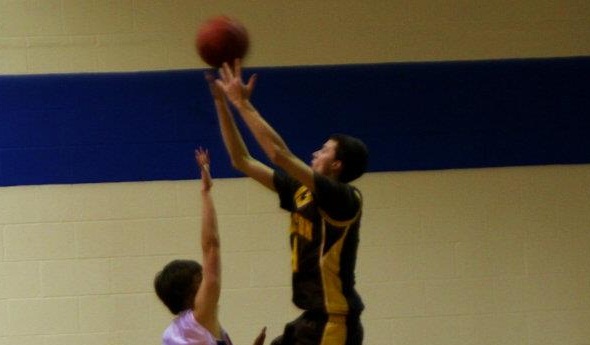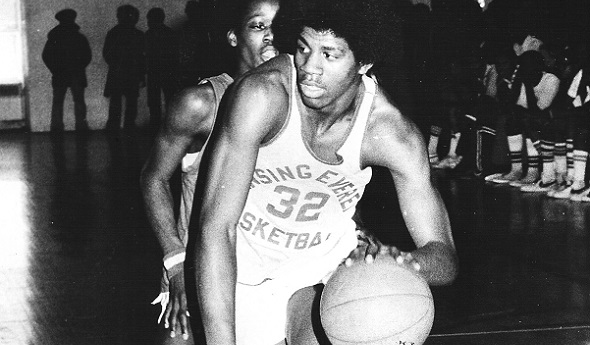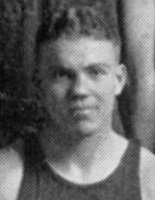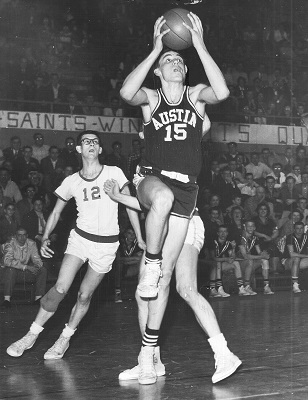
2,241 Reasons to Watch Chris Hass
February 14, 2012
Chris Hass began his freshman basketball season with his sights set on breaking an MHSAA career record.
But if you’ve heard at all of the Pellston High standout, it’s probably not the record you’d think.
Hass is one of just 34 players in MHSAA history to score at least 2,000 points. Only nine players have scored more than his 2,241 points heading into Wednesday’s game against Bellaire.
That record he wanted to break? Career assists, of course. And Hass has a bunch of those too. But the 6-foot-5 senior clearly is known for scoring in bunches few in MHSAA history have equaled.
“For me, it wasn’t something where it was my goal. I definitely feel honored to play on a team that’s willing to give me an opportunity to do that,” Hass said. “I guess it’s a big deal in northern Michigan, getting our name out there. Pellston is a small school, and to hit 2,000 points, it’s starting to get Pellston on the map, which is what the community deserves.”
Hass earned one of this week’s MHSAA High 5s not just for the ridiculous numbers he’s put up this season and over the last four, but for how he’s led the Class D Hornets into at least a glimmer of the state spotlight.
Pellston is 14-1 and can avenge its lone loss tonight against Bellaire, which beat the Hornets 75-58 on Jan. 17. Bellaire is ranked No. 1 and Pellston No. 3 in this week’s Associated Press Class D state poll.
Hass has a history with Bellaire – he scored 26 points in the fourth quarter alone before fouling out in a loss last season to Eagles. That’s the fourth-most points scored in a quarter in MHSAA history – and just one of the many listings Hass has or will have in the record book after his high school career ends sometime next month.
This season, he’s averaging 30.9 points, 8.5 rebounds, six assists, 4.5 steals and 2.5 blocked shots per game. He’s always been a strong ball-handler and continues to man the point despite an ability to play any position. He’s making 55 percent of his shots from the floor – including an incredible 52-percent success clip from 3-point range (he’s made 40 from beyond the arc).
“On nights when we really don’t need him to (score), he almost disappears into the background a little bit to get his teammates involved,” Cliff Hass said. “It’s really about the team, chemistry. He’s always one of the leaders trying to get chemistry (right). Does he love to have that 57-point night? That’s great, but he’s all about winning.”
So much so that Chris Hass almost committing to play next for Bethel College (Ind.), which has won seven NAIA national championships under its current coach, before settling on Bucknell after falling in love with the program and campus during a visit. There, Hass will join 2011 Petoskey graduate Cory Starkey on a team that made the NCAA Tournament last season.
"First and foremost, Chris is just a terrific scorer," said Bucknell coach Dave Paulsen in his program’s early-signing day press release. "He is an excellent shooter with great range, but he is also athletic and `bouncy' and can get to the rim. We expect that Chris will be able to give us a real explosive offensive presence from the perimeter."
Hass’ point total is exactly 600 short of the MHSAA record set by Mio’s Jay Smith from 1976-79. It’s unlikely Hass will break that record – he’d have to average 50 points a game through the MHSAA Final just to tie it – but being in the conversation is something special in itself.
Filling it up is nothing new in the Hass family. Older sister Stephanie Hass held the MHSAA girls scoring record with 2,732 points for a decade until Central Lake’s Jasmine Hines broke it last season. Hass, who played high school at Harbor Springs Harbor Light Christian – and then at Saginaw Valley State University – finished with a career scoring average of 31.4 points per game, tops in the record book.
And she never took it easy on her little brother.
Chris Hass remembered once, when he was 8 or so, getting so angry during a game of one-on-one that he started throwing rocks at his sister. But he also watched and emulated how she worked to improve her game. And around 12 years old, he beat her one-on-one for the first time.
“I do see similarities in both, offensively; ball-handling was probably their number one attribute. It’s the first thing I really noticed,” said Cliff Hass, their father and also Pellston’s boys varsity coach. “(And) they both developed that mentality of being able to score at any time.
“I tell all the players I coach, if you touch the ball 94 feet away (from the basket), your first goal is to score from 94 feet away. Being in the mentality of looking to score, you put pressure on the defense, and they have to stop you. And they might need a second person to try to stop you. “
Chris echoes his dad’s philosophy. But he wanted to make sure people saw him as more than a scorer. At Harbor Light in sixth and seventh grade, he’d been mostly a distributor passing to Collin Hewitt, who now plays at Spring Arbor. But Hass switched to his dad’s school for ninth grade, and began switching roles as well.
He still tries to get as many assists as he can. But although Pellston has other scorers (senior Andy Hamlin tallied his 1,000th career point this season), Hass knows for the Hornets to continue this run – and get a chance to show what they can do against competition from further down state – he needs to keep putting up the points.
“When you say you’re from the Petoskey area, people have no idea where that is,” Hass said. “Knowing we finally maybe might get some respect, I’m definitely excited about it.”

'Retro' Award Rewards 1st Hoops Legends
January 4, 2017
By Ron Pesch
Special for Second Half
Before the start of the MHSAA’s 2009 Boys Basketball finals, Basketball Coaches Association of Michigan director Tom Hursey stopped by my seat at Michigan State University’s Breslin Center to say hello.
Our chat would alter a decade of my Michigan winters.
Somewhere between hello and goodbye, our chat included conversation on one of my favorite BCAM ventures. In 1981, the Michigan High School Basketball Coaches Association, as BCAM was once known, named its first “Mr. Basketball.” I was two years out of high school when Lansing Eastern’s Sam Vincent edged Eric Turner of Flint Central for that first award. Designed to honor the state’s top senior, the award was named in honor of Detroit Free Press writer Hal Schram. “The Swami,” as he was nicknamed, Schram began covering high school sports for the newspaper in 1945.
The 2009 selection was 6-foot-9 Derrick Nix of Detroit Pershing. I mentioned my affinity for the Mr. Basketball program to Tom, but stated that I always thought it a crime that the award didn’t start years earlier, at least when Michigan hoop fans became infatuated with a kid nicknamed “Magic.”
Earvin Johnson prepped at Lansing Everett and was the talk of the state in basketball circles before becoming a household name during his time at Michigan State and with the Los Angeles Lakers. Earlier this year, ESPN named Johnson the greatest point guard to ever play the game. Tom noted that “Magic” was really the inspiration for the “Mr. Basketball” award.
Then I posed a question to Tom.
What about creating a “new” award, designed to honor those greats from the past?
As my hobby of researching the history of high school sports in Michigan and beyond had grown over the years, I’d found the Great Lakes state had always produced shining stars on the basketball court. The crime was that the “Mr. Basketball” award hadn’t been launched many years before.
Harry Kipke, was perhaps the state’s first true basketball star. He won 12 varsity letters at Lansing Central and guided the basketball team to the semifinal round of the state tournament in 1920 as a senior, before heading to the University of Michigan where he earned letters in football, basketball and baseball. After stops at the University of Missouri and Michigan State, Kipke would serve as Michigan’s football coach, guiding the Wolverines to two national gridiron championships.
 As a junior, the basketball antics of Grand Rapids Union’s Royal “Red” Cherry captured the state’s attention when he led Union to the state basketball championship. Considered the best all-around player of the tournament, Cherry led the team to a second consecutive title as a senior. He, too, attended Michigan, earning laurels on the basketball court and the baseball diamond.
As a junior, the basketball antics of Grand Rapids Union’s Royal “Red” Cherry captured the state’s attention when he led Union to the state basketball championship. Considered the best all-around player of the tournament, Cherry led the team to a second consecutive title as a senior. He, too, attended Michigan, earning laurels on the basketball court and the baseball diamond.
Many other legends of the hardcourt populated Michigan’s past: Saginaw’s Ernie Thompson; the Burton brothers, M.C. and Ed, of Muskegon Heights; Detroit Pershing’s Ralph Simpson and Spencer Haywood; Dave DeBusschere of Detroit Austin Catholic; Willie Betts and Blanche Martin of River Rouge; Ron Kramer of East Detroit; Benton Harbor’s Chet Walker and L.C. Bowen.
After a few weeks of research, discussion and thought, Tom agreed, and over the next several months the framework for the “Retro Mr. Basketball” project was developed
The idea was to try and mimic the current model. Only seniors, and their high school basketball careers, should be considered. While any “senior” player would be eligible, a ballot of the state’s elite would comprise the candidates for the award. Like their modern-day equivalents, where the events of life that would follow high school graduation had yet to occur, post-high school life would be disregarded as much as possible for “Retro” candidates.
Finally, the program would follow a 10-year arc, kicking off in the spring of 2010. This December marks my eighth year of research tied to the mission. Two more will follow.
Since the Schram “Mr. Basketball” award began in 1981, the “Retro” award would honor basketball players from the years 1920 through 1980. That first year, a ballot comprised of players from the years that ended in zero - 1920, 1930, 1940, 1950, 1960, 1970 and 1980 – was created. A senior for each year would be named the winner of the “Retro” award. That meant with the selection of “Mr. Basketball” and the six “Retro” winners for the years 1929, 1939, 1949, 1959, 1969 and 1979, scheduled for the spring of 2019, BCAM would be able to point to a combined list of Mr. Basketballs totaling 100 of the state’s finest.
To identify each year’s award winner, a committee of veteran BCAM members was formed to study a ballot of candidates and select a winner.
Technology, combined with scanning old-fashioned reels of microfilm, has helped with research of potential candidates. In those very early years, personal statistics were rarely kept. Rather, an assessment of a player’s skills, tied to the position he played, often served as a means to identify an area’s top athletes. Tournament play was often the only time an athlete’s abilities were on display to a larger audience. Scouring newspaper articles for all-tournament teams and yearbooks for additional details and years of study helped uncover the state’s top senior players. Understanding the game and its evolution was important. The center jump after each basket emphasized the importance of a tall, skilled center in those games played before the winter of 1938-39.
Beginning in 1935, all-state teams began to appear in state newspapers. Eventually, the Detroit Free Press, the Detroit Times, the Detroit News, The Associated Press and even United Press International became involved in identifying the state’s top basketball players and naming all-state squads. Much work is involved in parsing the 15,811 names (not including honorable mentions) found in those lists. When duplicates are removed, the names of 8,430 prep players remain spread over the 61 years that mark the “Retro” field of possible candidates.
Research to identify seniors, players named by multiple media outlets, and mini biographies are compiled for the top players. The field of candidates is then narrowed to 10 or fewer. Over state championship weekend, the ballots are brought to the BCAM committee for discussion, and finalists are named for each year. Finally, one player is named for each eligible season.
Like the modern day award, the selection may create some controversy. Some amazing ballplayers have landed on the finalist list, but were denied the Hal Schram Mr. Basketball award: Traverse City’s Dan Majerle, Roy Marble of Flint Beecher, Detroit Southwestern’s Jalen Rose, Detroit Northern’s Derrick Coleman and Draymond Green of Saginaw are among a few.
 The same applies to the “Retro” list. Fennville’s Richie Jordan, Robert “Bubbles” Hawkins from Detroit Pershing, Dennis Bankey of Detroit St. Thomas, Bill Chmielewski of Detroit Redeemer, Highland Park’s Terry Duerod and Detroit Kettering’s Lindsay Hairston all have been honored on the finalist lists, but fell short of the top prize.
The same applies to the “Retro” list. Fennville’s Richie Jordan, Robert “Bubbles” Hawkins from Detroit Pershing, Dennis Bankey of Detroit St. Thomas, Bill Chmielewski of Detroit Redeemer, Highland Park’s Terry Duerod and Detroit Kettering’s Lindsay Hairston all have been honored on the finalist lists, but fell short of the top prize.
In many cases, Michigan was loaded with prep talent – it’s tough to name Roy Marble Mr. Basketball when Flint Northwestern’s Glen Rice was on the same ballot, or Rose the state’s best when Country Day’s Chris Webber was another candidate. While the “Fennville Flash” amazed the state with his eye-popping statistics in 1965, Bowen led Benton Harbor to back-to-back Class A titles. Named an all-state basketball player as a junior, Hairston grew an inch and improved his game as a senior, but Pontiac Central’s “Campy” Russell dominated headlines that season, and was the “Retro” Mr. Basketball selection for 1971.
In some cases, it’s a challenge to look at the final balloting results without judging selections based on future basketball success. That certainly is the case with 2008. That season, Michigan’s Mr. Basketball award went to 6-foot guard Brad Redford, who posted incredible back-to-back high school seasons at Frankenmuth. Runner-up to the award that year was Saginaw’s Green. Considering Green’s success in the NBA, that’s hard for many to believe.
While the debates may never be settled, the beauty of Schram and “Retro” Mr. Basketball balloting can be found in the argument. With those disputes, people recall, research and learn about Michigan’s incredible prep basketball past.
The remaining three years of the “Retro” project will include many more legends of Michigan High School basketball, including, among others, DeBusschere, Walker, Haywood and Simpson.
This season, that “Magic” kid will be one of the names among the mix. Forty years after high school graduation, will he earn the honor that eluded him in high school, only because the honor didn’t yet exist?
 Ron Pesch has taken an active role in researching the history of MHSAA events since 1985 and began writing for MHSAA Finals programs in 1986, adding additional features and "flashbacks" in 1992. He inherited the title of MHSAA historian from the late Dick Kishpaugh following the 1993-94 school year, and resides in Muskegon. Contact him at [email protected] with ideas for historical articles.
Ron Pesch has taken an active role in researching the history of MHSAA events since 1985 and began writing for MHSAA Finals programs in 1986, adding additional features and "flashbacks" in 1992. He inherited the title of MHSAA historian from the late Dick Kishpaugh following the 1993-94 school year, and resides in Muskegon. Contact him at [email protected] with ideas for historical articles.
PHOTOS: (Top) Lansing Everett’s Earvin Johnson drives around a defender during his celebrated high school career. (Middle) Grand Rapids Union’s Royal “Red” Cherry. (Below) Detroit Austin Catholic’s Dave DeBusschere drives to the hoop as an opponent gets in position to rebound. (Photos from MHSAA and Ron Pesch historical files.)

